Abstract
Flux rates of amino acids were measured across the leg after an overnight fast in resting human volunteers. A balanced amino acid solution was, after a primed infusion, continuously infused for 2 h at each of three step-wise and increasing rates corresponding to 8.3, 16.7, 33.2 mg N/kg per h that were equivalent to 0.2, 0.4, 0.8 g N/kg per d. Flux of amino acids across the leg was compared with the flux of glucose, glycerol, lactate, free fatty acids, and oxygen. The size of the muscular tissue pool of amino acids was measured. Whole body amino acid oxidation was estimated by means of the continuous infusion of a 14C-labeled mixture of amino acids. Arterial steady state levels were obtained for most amino acids within 30 to 45 min after the primed constant infusion. Leg flux of amino acids switched from a net efflux after an overnight fast to a balanced flux between infusion rates corresponding to 0.2-0.4 g N/kg per d. At 0.8 g N/kg per d essentially all amino acids showed uptake. The infusion of amino acids stimulated leg uptake of glucose and lactate production and decreased FFA release. Oxygen uptake and leg blood flow increased significantly with increased infusion of amino acids. There was significant variability in transport rate among individual amino acids. Branched chain amino acids showed rapid transport and methionine slow transport rate. Only small changes in the muscle tissue concentration of certain amino acids were registered after 6 h of amino acid infusion despite uptake for several hours. When amino acids were infused at a rate corresponding to 0.8 g N/kg per d, the leg uptake of amino acids was 6% and the simultaneous whole body oxidation of infused amino acids was approximately 10%. Net uptake of leucine across the leg per hour was 62% of the muscle pool of free leucine when amino acids were infused at a rate corresponding to 0.4 g N/kg per d. Multiple regression analysis showed that the arterial concentration of an amino acid was the most important factor for uptake, more so than insulin concentration and blood flow. It is concluded that leg exchange of amino acids is large enough to rapidly change the pool size of the amino acids in skeletal muscle, if not counter-regulated by changes in rates of protein synthesis and degradation. Estimates of the capacity for protein synthesis and transfer RNA acceptor sites in muscles agree in order of magnitude with the net uptake of amino acids at high infusion rates of amino acids. Therefore, measurements of the balance of tyrosine, phenylalanine, and particularly methionine at steady state may reflect net balance of proteins across skeletal muscles even in short-time experiments.
Full text
PDF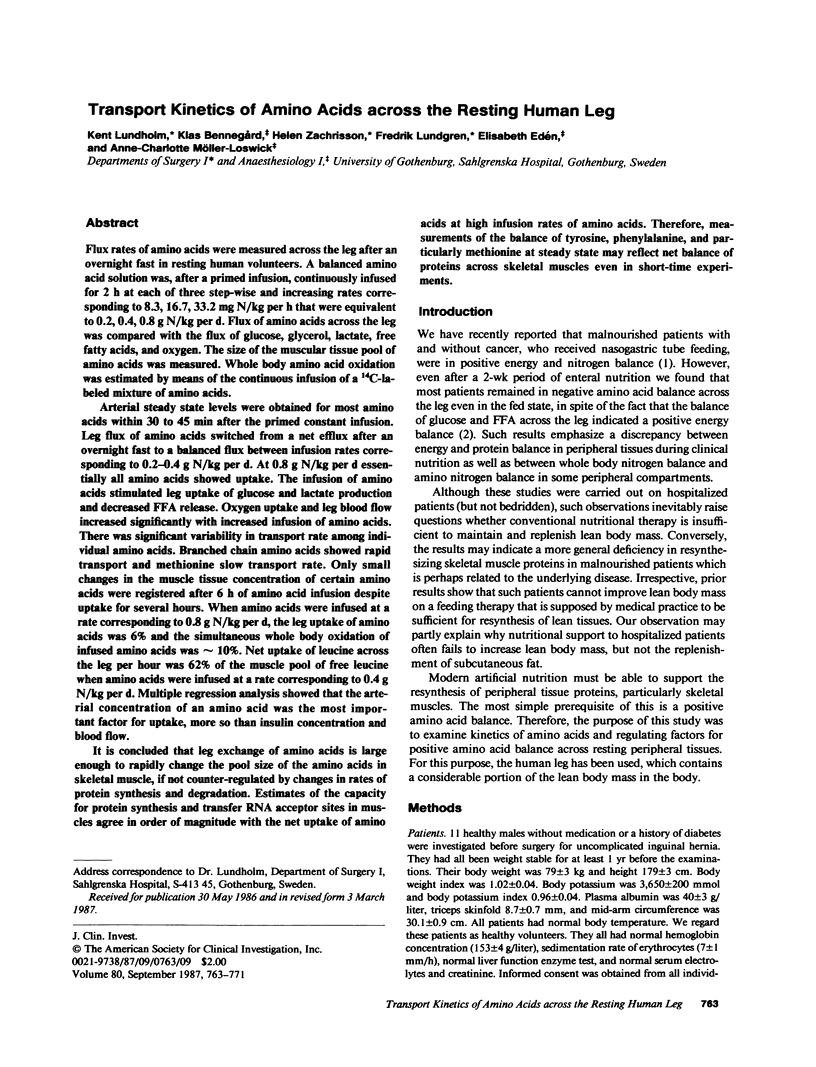
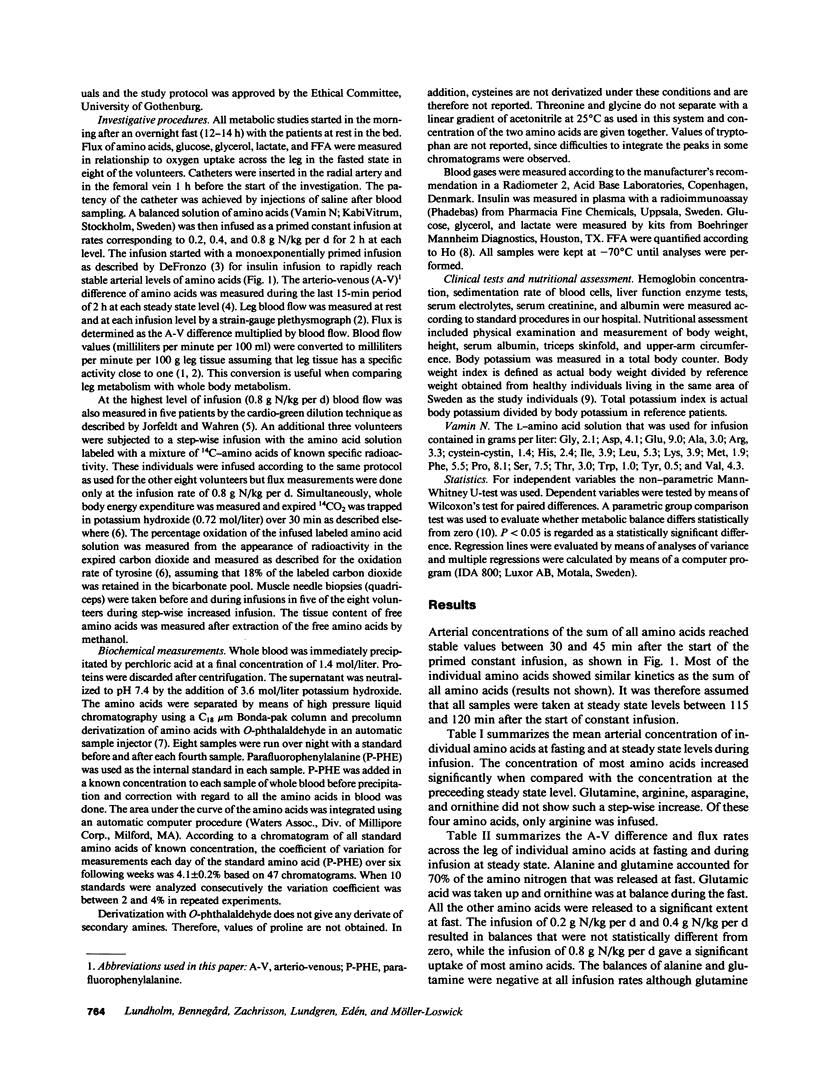
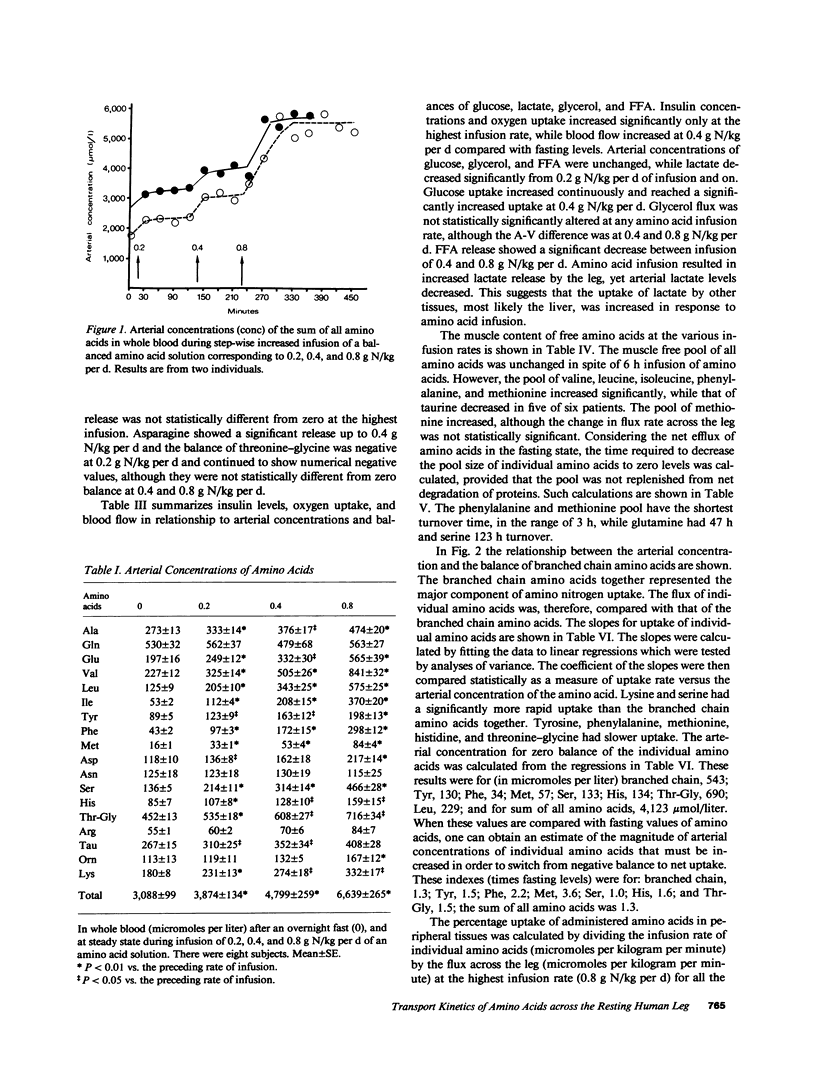
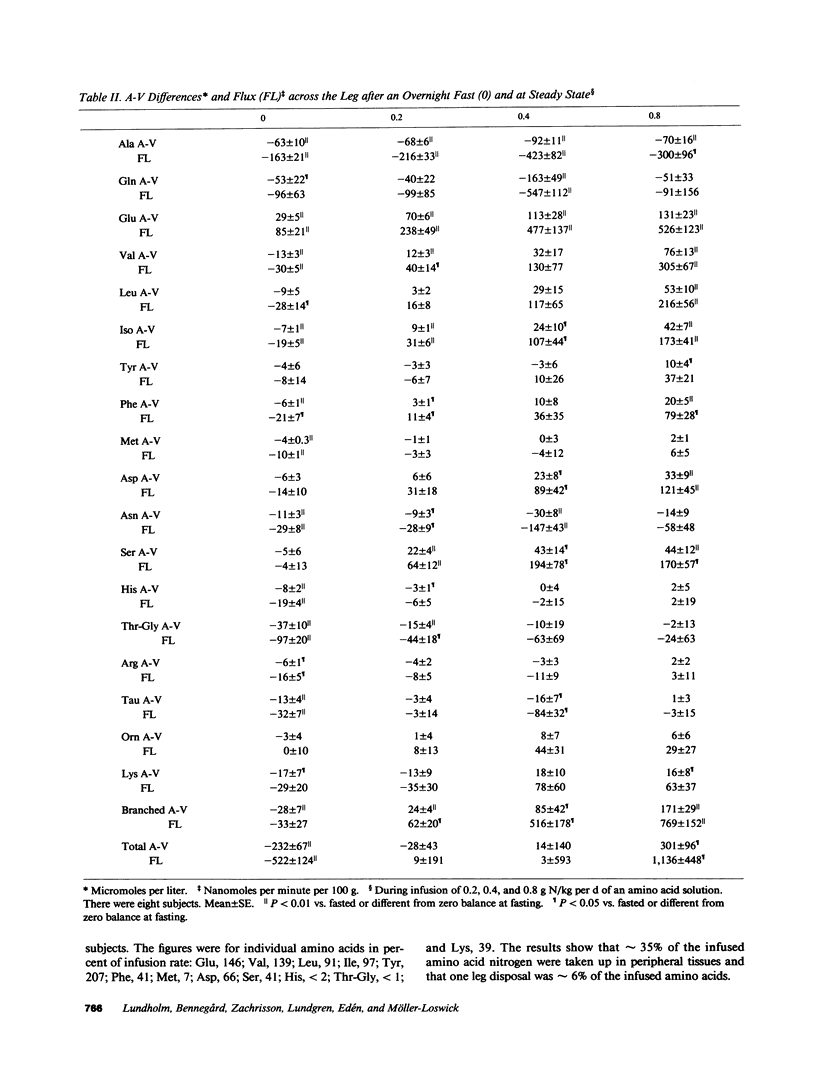
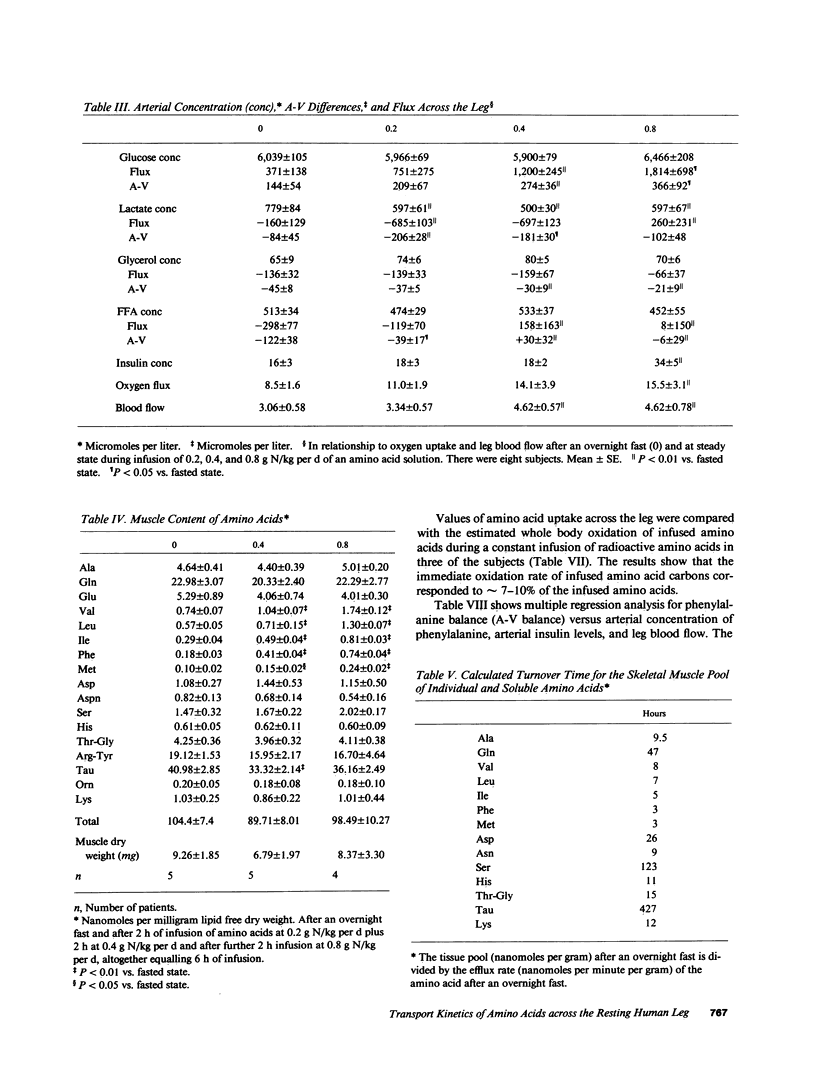
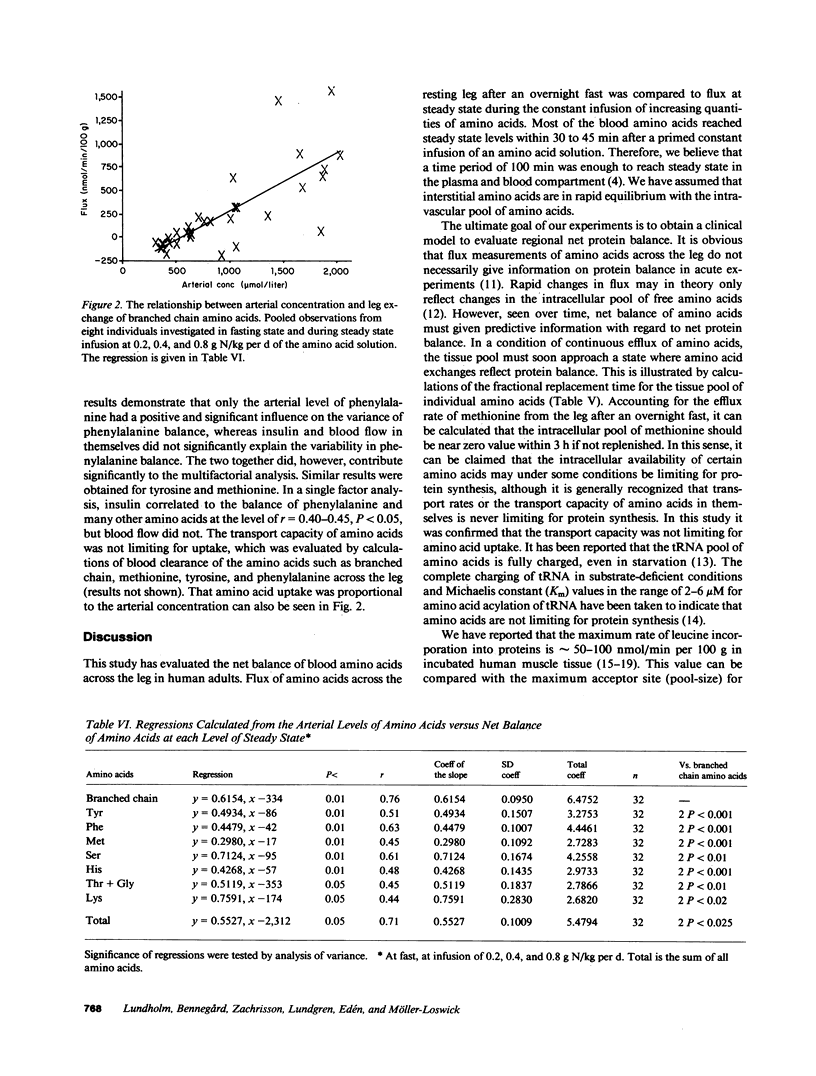
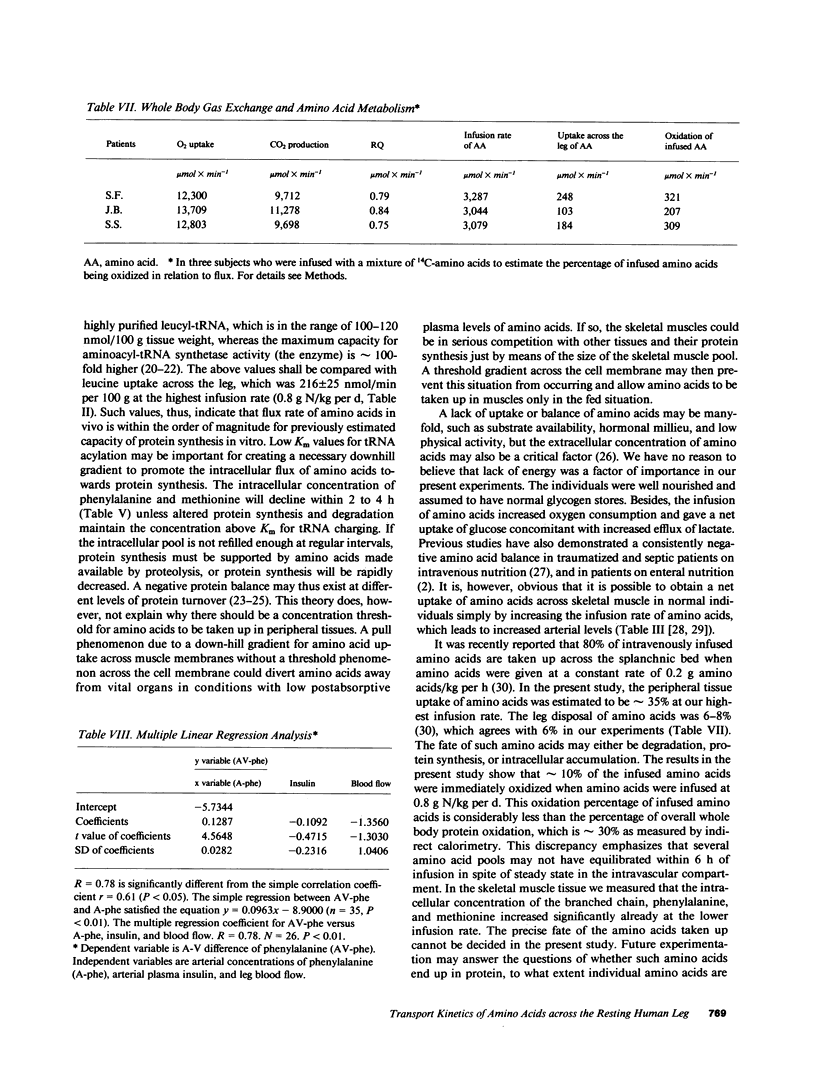
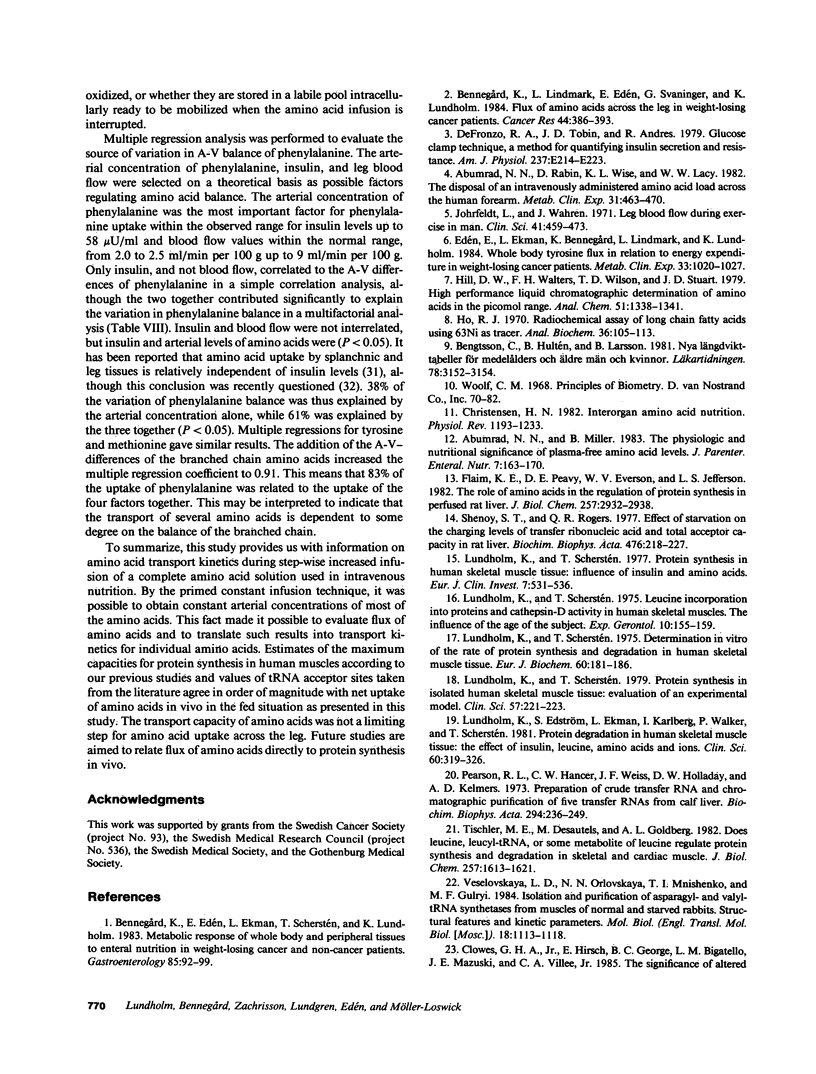
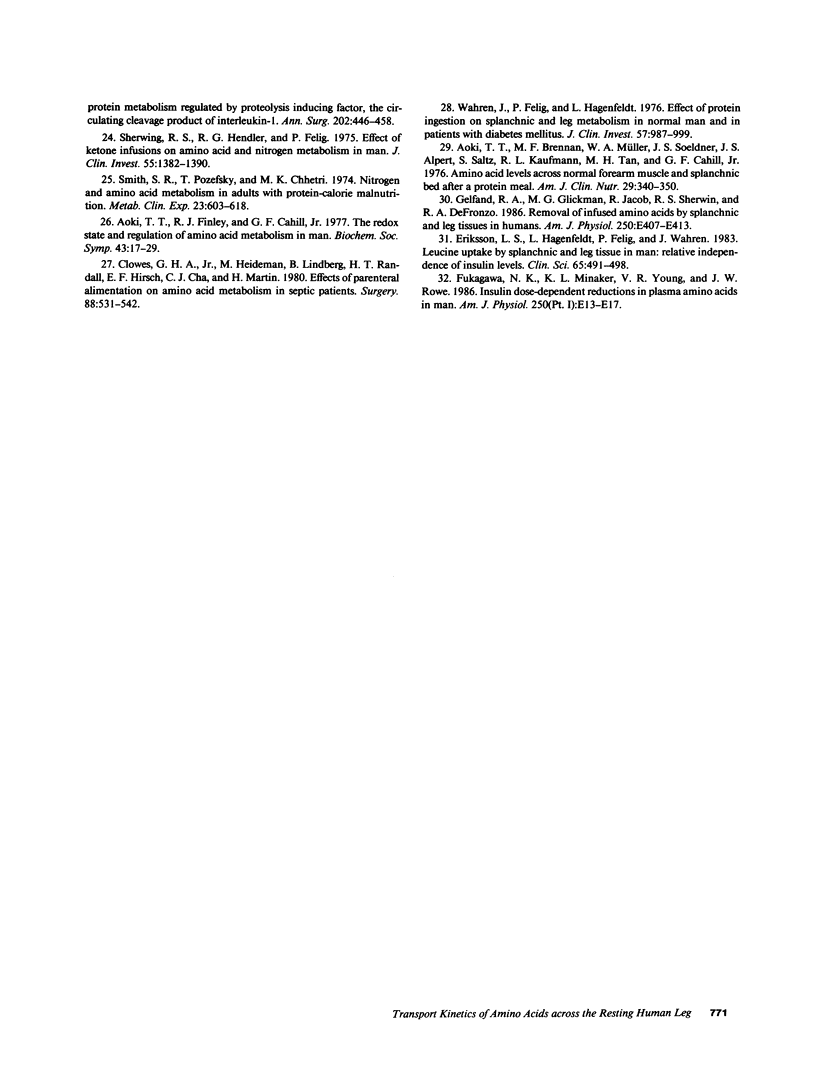
Selected References
These references are in PubMed. This may not be the complete list of references from this article.
- Abumrad N. N., Miller B. The physiologic and nutritional significance of plasma-free amino acid levels. JPEN J Parenter Enteral Nutr. 1983 Mar-Apr;7(2):163–170. doi: 10.1177/0148607183007002163. [DOI] [PubMed] [Google Scholar]
- Abumrad N. N., Rabin D., Wise K. L., Lacy W. W. The disposal of an intravenously administered amino acid load across the human forearm. Metabolism. 1982 May;31(5):463–470. doi: 10.1016/0026-0495(82)90235-9. [DOI] [PubMed] [Google Scholar]
- Aoki T. T., Brennan M. F., Müller W. A., Soeldner J. S., Alpert J. S., Saltz S. B., Kaufmann R. L., Tan M. H., Cahill G. F., Jr Amino acid levels across normal forearm muscle and splanchnic bed after a protein meal. Am J Clin Nutr. 1976 Apr;29(4):340–350. doi: 10.1093/ajcn/29.4.340. [DOI] [PubMed] [Google Scholar]
- Aoki T. T., Finley R. J., Cahill G. F., Jr The redox state and regulation of amino acid metabolism in man. Biochem Soc Symp. 1978;(43):17–29. [PubMed] [Google Scholar]
- Bengtsson C., Hultén B., Larsson B., Noppa H., Steen B., Warnold I. Nya längd-vikttabeller för medelålders och äldre män och kvinnor. Lakartidningen. 1981 Sep 9;78(37):3152–3154. [PubMed] [Google Scholar]
- Bennegård K., Edén E., Ekman L., Scherstén T., Lundholm K. Metabolic response of whole body and peripheral tissues to enteral nutrition in weight-losing cancer and noncancer patients. Gastroenterology. 1983 Jul;85(1):92–99. [PubMed] [Google Scholar]
- Bennegård K., Lindmark L., Edén E., Svaninger G., Lundholm K. Flux of amino acids across the leg in weight-losing cancer patients. Cancer Res. 1984 Jan;44(1):386–393. [PubMed] [Google Scholar]
- Christensen H. N. Interorgan amino acid nutrition. Physiol Rev. 1982 Oct;62(4 Pt 1):1193–1233. doi: 10.1152/physrev.1982.62.4.1193. [DOI] [PubMed] [Google Scholar]
- Clowes G. H., Jr, Heideman M., Lindberg B., Randall H. T., Hirsch E. F., Cha C. J., Martin H. Effects of parenteral alimentation on amino acid metabolism in septic patients. Surgery. 1980 Oct;88(4):531–543. [PubMed] [Google Scholar]
- Clowes G. H., Jr, Hirsch E., George B. C., Bigatello L. M., Mazuski J. E., Villee C. A., Jr Survival from sepsis. The significance of altered protein metabolism regulated by proteolysis inducing factor, the circulating cleavage product of interleukin-1. Ann Surg. 1985 Oct;202(4):446–458. doi: 10.1097/00000658-198510000-00006. [DOI] [PMC free article] [PubMed] [Google Scholar]
- DeFronzo R. A., Tobin J. D., Andres R. Glucose clamp technique: a method for quantifying insulin secretion and resistance. Am J Physiol. 1979 Sep;237(3):E214–E223. doi: 10.1152/ajpendo.1979.237.3.E214. [DOI] [PubMed] [Google Scholar]
- Edén E., Ekman L., Bennegård K., Lindmark L., Lundholm K. Whole-body tyrosine flux in relation to energy expenditure in weight-losing cancer patients. Metabolism. 1984 Nov;33(11):1020–1027. doi: 10.1016/0026-0495(84)90231-2. [DOI] [PubMed] [Google Scholar]
- Eriksson L. S., Hagenfeldt L., Felig P., Wahren J. Leucine uptake by splanchnic and leg tissues in man: relative independence of insulin levels. Clin Sci (Lond) 1983 Nov;65(5):491–498. doi: 10.1042/cs0650491. [DOI] [PubMed] [Google Scholar]
- Flaim K. E., Peavy D. E., Everson W. V., Jefferson L. S. The role of amino acids in the regulation of protein synthesis in perfused rat liver. I. Reduction in rates of synthesis resulting from amino acid deprivation and recovery during flow-through perfusion. J Biol Chem. 1982 Mar 25;257(6):2932–2938. [PubMed] [Google Scholar]
- Gelfand R. A., Glickman M. G., Jacob R., Sherwin R. S., DeFronzo R. A. Removal of infused amino acids by splanchnic and leg tissues in humans. Am J Physiol. 1986 Apr;250(4 Pt 1):E407–E413. doi: 10.1152/ajpendo.1986.250.4.E407. [DOI] [PubMed] [Google Scholar]
- Hill D. W., Walters F. H., Wilson T. D., Stuart J. D. High performance liquid chromatographic determination of amino acids in the picomole range. Anal Chem. 1979 Jul;51(8):1338–1341. doi: 10.1021/ac50044a055. [DOI] [PubMed] [Google Scholar]
- Ho R. J. Radiochemical assay of long-chain fatty acids using 63Ni as tracer. Anal Biochem. 1970 Jul;36(1):105–113. doi: 10.1016/0003-2697(70)90337-4. [DOI] [PubMed] [Google Scholar]
- Jorfeldt L., Wahren J. Leg blood flow during exercise in man. Clin Sci. 1971 Nov;41(5):459–473. doi: 10.1042/cs0410459. [DOI] [PubMed] [Google Scholar]
- Lundholm K., Edström S., Ekman L., Karlberg I., Walker P., Scherstén T. Protein degradation in human skeletal muscle tissue: the effect of insulin, leucine, amino acids and ions. Clin Sci (Lond) 1981 Mar;60(3):319–326. doi: 10.1042/cs0600319. [DOI] [PubMed] [Google Scholar]
- Lundholm K., Scherstén T. Determination in vitro of the rate of protein synthesis and degradation in human-skeletal-muscle tissue. Eur J Biochem. 1975 Dec 1;60(1):181–186. doi: 10.1111/j.1432-1033.1975.tb20990.x. [DOI] [PubMed] [Google Scholar]
- Lundholm K., Scherstén T. Leucine incorporation into proteins and cathepsin -D activity in human skeletal muscles. The influence of the age of the subject. Exp Gerontol. 1975 Apr;10(2):155–159. doi: 10.1016/0531-5565(75)90045-5. [DOI] [PubMed] [Google Scholar]
- Lundholm K., Scherstén T. Protein synthesis in human skeletal muscle tissue: influence of insulin and amino acids. Eur J Clin Invest. 1977 Dec;7(6):531–536. doi: 10.1111/j.1365-2362.1977.tb01647.x. [DOI] [PubMed] [Google Scholar]
- Lundholm K., Scherstén T. Protein synthesis in isolated human skeletal muscle tissue: evaluation of an experimental model. Clin Sci (Lond) 1979 Aug;57(2):221–223. doi: 10.1042/cs0570221. [DOI] [PubMed] [Google Scholar]
- Pearson R. L., Hancher C. W., Weiss J. F., Holladay D. W., Kelmers A. D. Preparation of crude transfer RNA and chromatographic purification of five transfer RNAs from calf liver. Biochim Biophys Acta. 1973 Jan 19;294(2):236–249. [PubMed] [Google Scholar]
- Shenoy S. T., Rogers Q. R. Effect of starvation on the charging levels of transfer ribonucleic acid and total acceptor capacity in rat liver. Biochim Biophys Acta. 1977 Jun 3;476(3):218–227. doi: 10.1016/0005-2787(77)90005-3. [DOI] [PubMed] [Google Scholar]
- Sherwin R. S., Hendler R. G., Felig P. Effect of ketone infusions on amino acid and nitrogen metabolism in man. J Clin Invest. 1975 Jun;55(6):1382–1390. doi: 10.1172/JCI108057. [DOI] [PMC free article] [PubMed] [Google Scholar]
- Smith S. R., Pozefsky T., Chhetri M. K. Nitrogen and amino acid metabolism in adults with protein-calorie malnutrition. Metabolism. 1974 Jul;23(7):603–618. doi: 10.1016/s0026-0495(74)80020-x. [DOI] [PubMed] [Google Scholar]
- Tischler M. E., Desautels M., Goldberg A. L. Does leucine, leucyl-tRNA, or some metabolite of leucine regulate protein synthesis and degradation in skeletal and cardiac muscle? J Biol Chem. 1982 Feb 25;257(4):1613–1621. [PubMed] [Google Scholar]
- Wahren J., Felig P., Hagenfeldt L. Effect of protein ingestion on splanchnic and leg metabolism in normal man and in patients with diabetes mellitus. J Clin Invest. 1976 Apr;57(4):987–999. doi: 10.1172/JCI108375. [DOI] [PMC free article] [PubMed] [Google Scholar]


